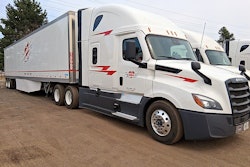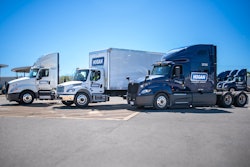When you are accustomed to growth in the mid-double digits, 9 percent can seem rather anemic. That’s about how much revenues grew in 2006 for the CCJ Top 250 – the nation’s leading for-hire carriers in terms of revenues, fleet size and employment. It’s far below the increases of 16.1 percent and 14 percent in 2005 and 2004, respectively.
Yes, for most, the wild, wonderful ride appears to have ended for now. But trucking executives should put the recent past into perspective. For one thing, some of the CCJ Top 250 revenue surge in 2004 and 2005 stemmed from consolidation rather than organic growth, and from one-time events such as the expansion of package-delivery firm DHL Express in the U.S. market. In 2006, there was less merger activity involving major trucking companies.
But you don’t have to discount recent gains to appreciate the relative strength of 2006. Historically, 9 percent growth would have been seen as quite strong for the CCJ Top 100, the predecessor for the CCJ Top 250. Since deregulation in 1980, the Top 100 had surpassed a 9 percent year-over-year increase only four times – 1984, 1994, 1996 and 1999. And besides, slower growth is still growth – and it came on top of a strong year.
Still, 2006 results point to the relative softness trucking companies are experiencing today. For example, the number of power units operated by the CCJ Top 250 rose by more than 10 percent in 2006 – a bit higher than the increase in revenues. In 2005, however, the double-digit revenue growth came at the same time that the number of trucks and tractors actually declined by 2.6 percent.
Shifts in the makeup of the CCJ Top 250 due to consolidation, changes in carrier reporting and other factors can skew year-over-year comparisons somewhat. But the basic message remains that 2005 was a year of tight capacity and strong freight, helping to drive higher pricing. And clearly, capacity wasn’t as tight in 2006. Changes in driver employment reinforce this point. While the driver force – company drivers and owner-operators – declined in 2005 by 2 percent, it surged 11.9 percent in 2006. So revenue growth in 2005 seems to have been driven mostly by pricing, while the slower 2006 growth seems to be driven mostly by volume.
Trucking companies constrained by a driver shortage and other factors may have taken the opportunity in 2006 to load up on pre-2007 trucks and hire more readily available drivers – just as the freight demand that had driven strong revenues and profits in recent years was softening. The result would be a swing from tight capacity to overcapacity. If that’s the case, however, the effect seems to have been relatively mild so far.
Despite some sluggishness in freight and little sign of near-term improvements in the troubled housing sector, there are few indications of a downturn bearing any resemblance to the bloodletting of 2000 through 2002. Among the publicly traded carriers, for example, the results are mixed – last month, some reported lower second-quarter profits, while others saw higher earnings than a year ago.
Slower growth all around
Every major industry segment represented in the CCJ Top 250 saw slower revenue growth in 2006 than in 2005. Two segments that showed particular weakness were household goods and motor vehicles, mirroring trends in the overall housing and automobile sectors.
In 2005, revenues for household goods carriers in the CCJ Top 250 rose 9.4 percent. Last year, growth slowed to just 1.1 percent. That’s not too surprising given the collapse in home sales in the latter part of 2006 and the resulting drop in the need for moving services. Similarly, car haulers posted revenue growth of 7.9 percent in 2005, but revenues were virtually flat last year.
One surprise was that flatbed and heavy haul operations continued to lead the CCJ Top 250 in revenue growth despite the downturn in housing. Although well below the 19.5 percent increase in 2005, the 14.7 percent rise was one of only two double-digit gains.
Such strength seems counterintuitive, but several factors may explain it. First, the downturn in housing didn’t hit until fairly late in the year, and many of the surplus homes already were built or under construction when sales collapsed. Also, nonresidential construction remained strong even as housing fell, so some carriers may have shifted to hauling construction equipment and structural steel, for example, rather than lumber and shingles.
And then there’s the Katrina effect. While demand may have been low in many of the nation’s population centers, Hurricane Katrina and other 2005 Gulf Coast hurricanes fueled demand for rebuilding in the region. One way to get a very rough indication of Katrina’s impact is to exclude from the flatbed/heavy haul category those carriers that are based in Louisiana or bordering states. Removing those carriers cuts the revenue growth for the segment to 8.8 percent.
Few departures at the top
The top of the CCJ Top 250 ranking wasn’t affected much by major merger and acquisition activity. The biggest departure was Watkins Motor Lines, which ranked No. 25 in 2005. FedEx Freight last year acquired Watkins and rebranded it as FedEx National LTL. FedEx Freight’s results include the LTL operation as well as the FedEx Custom Critical expedited freight operation, which ranked No. 55 last year. Lumping those operations into FedEx Freight propelled the company to No. 4 from No. 6. That may be only two spots, but that’s hard to achieve at the top of the list.
By absorbing Watkins, FedEx furthered the concentration of LTL and package delivery into three corporate entities – UPS, Federal Express and YRC Worldwide. Among them, the three corporate umbrellas own six of the 10 largest carriers in the CCJ Top 250 and eight of the 20 largest carriers. And with No. 11 Con-way’s move to acquire No. 58 CFI, might we see some of the package and LTL giants looking to buy truckload carriers?
To view a pdf of The CCJ Top 250, click here.








